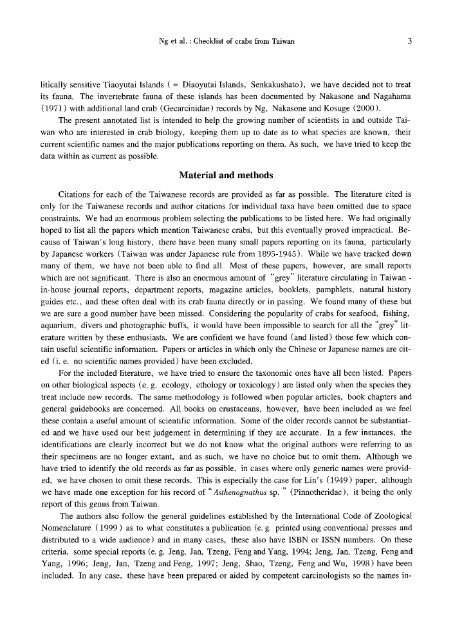An annotated checklist of brachyuran crabs from Taiwan (Crustacea ...
An annotated checklist of brachyuran crabs from Taiwan (Crustacea ...
An annotated checklist of brachyuran crabs from Taiwan (Crustacea ...
You also want an ePaper? Increase the reach of your titles
YUMPU automatically turns print PDFs into web optimized ePapers that Google loves.
Ng et al. : Checklist <strong>of</strong> <strong>crabs</strong> <strong>from</strong> <strong>Taiwan</strong> 3<br />
litically sensitive Tiaoyutai Islands ( = Diaoyutai Islands, Senkakushato), we have decided not to treat<br />
its fauna. The invertebrate fauna <strong>of</strong> these islands has been documented by Nakasone and Nagahama<br />
(1971) with additional land crab (Gecarcinidae) records by Ng, Nakasone and Kosuge (2000).<br />
The present <strong>annotated</strong> list is intended to help the growing number <strong>of</strong> scientists in and outside <strong>Taiwan</strong><br />
who are interested in crab biology, keeping them up to date as to what species are known, their<br />
current scientific names and the major publications reporting on them. As such, we have tried to keep the<br />
data within as current as possible.<br />
Material and methods<br />
Citations for each <strong>of</strong> the <strong>Taiwan</strong>ese records are provided as far as possible. The literature cited is<br />
only for the <strong>Taiwan</strong>ese records and author citations for individual taxa have been omitted due to space<br />
constraints. We had an enormous problem selecting the publications to be listed here. We had originally<br />
hoped to list all the papers which mention <strong>Taiwan</strong>ese <strong>crabs</strong>, but this eventually proved impractical. Because<br />
<strong>of</strong> <strong>Taiwan</strong>'s long history, there have been many small papers reporting on its fauna, particularly<br />
by Japanese workers (<strong>Taiwan</strong> was under Japanese rule <strong>from</strong> 1895-1945). While we have tracked down<br />
many <strong>of</strong> them, we have not been able to find all. Most <strong>of</strong> these papers, however, are small reports<br />
which are not significant. There is also an enormous amount <strong>of</strong> "grey" literature circulating in <strong>Taiwan</strong> -<br />
in-house journal reports, department reports, magazine articles, booklets, pamphlets, natural history<br />
guides etc., and these <strong>of</strong>ten deal with its crab fauna directly or in passing. We found many <strong>of</strong> these but<br />
we are sure a good number have been missed. Considering the popularity <strong>of</strong> <strong>crabs</strong> for seafood, fishing,<br />
aquarium, divers and photographic buffs, it would have been impossible to search for all the "grey" literature<br />
written by these enthusiasts. We are confident we have found (and listed) those few which contain<br />
useful scientific information. Papers or articles in which only the Chinese or Japanese names are cited<br />
(i. e. no scientific names provided) have been excluded.<br />
For the included literature, we have tried to ensure the taxonomic ones have all been listed. Papers<br />
on other biological aspects (e. g. ecology, ethology or toxicology) are listed only when the species they<br />
treat include new records. The same methodology is followed when popular articles, book chapters and<br />
general guidebooks are concerned. All books on crustaceans, however, have been included as we feel<br />
these contain a useful amount <strong>of</strong> scientific information. Some <strong>of</strong> the older records cannot be substantiated<br />
and we have used our best judgement in determining if they are accurate. In a few instances, the<br />
identifications are clearly incorrect but we do not know what the original authors were referring to as<br />
their specimens are no longer extant, and as such, we have no choice but to omit them. Although we<br />
have tried to identify the old records as far as possible, in cases where only generic names were provided,<br />
we have chosen to omit these records. This is especially the case for Lin's (1949) paper, although<br />
we have made one exception for his record <strong>of</strong> " Asthenognathus sp. " (Pinnotheridae), it being the only<br />
report <strong>of</strong> this genus <strong>from</strong> <strong>Taiwan</strong>.<br />
The authors also follow the general guidelines established by the International Code <strong>of</strong> Zoological<br />
Nomenclature (1999 ) as to what constitutes a publication (e. g. printed using conventional presses and<br />
distributed to a wide audience) and in many cases, these also have ISBN or ISSN numbers. On these<br />
criteria, some special reports (e. g. Jeng, Jan, Tzeng, Feng and Yang, 1994; Jeng, Jan, Tzeng, Feng and<br />
Yang, 1996; Jeng, Jan, Tzeng and Feng, 1997; Jeng, Shao, Tzeng, Feng and Wu, 1998) have been<br />
included. In any case, these have been prepared or aided by competent carcinologists so the names in-

















